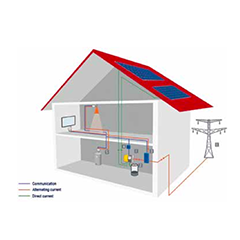The topic of self-consumption is one of the most discussed in the photovoltaic industry. And while self-consumption is not limited to the immediate use of electricity generated during the day, it is also applied to extend the availability of electricity during the night-time with the aid of battery storage systems. Indeed, they can help elevate PV to the next level…
At the recent Intersolar Europe 2013, several interesting solutions enabling an implementation of this concept were presented, such as the prototype of the “SolarMax P-Battery” Upgrade Kit by the Swiss company Sputnik Engineering, which can be inserted into the SolarMax P series inverters.
At the beginning of 2013, the European PV Industry Association (EPIA) endorsed a working paper on PV storage which identified a strong need to encourage storage systems at a consumer and distribution level. And apart from a difficult market situation for PV in Europe – which is currently facing massive reductions of Feed-in Tariffs, political arbitrariness and the consequences of the introduction of import duties on Chinese solar panels, cells and wafers – the industry finds itself beyond grid parity in many European countries already.
The next step for PV to become more attractive on a wider scale, i.e. for private households, would be to start mass deployment of storage solutions for PV self-consumption, as this would also avoid or delay the need for costly grid reinforcements and extensions.
EPIA points out that PV storage at household level can raise the maximum amount of self-consumption available from the current 30 per cent to around 70 per cent. With dropping Feed-in Tariffs for PV electricity, the savings for homeowners who consume their own power can increase sharply, while reducing the need to buy more costly retail electricity and lessening the amount of increasingly smaller rewards from selling PV power back to the grid at wholesale prices, which would make investing in storage solutions an attractive option.
Supporting the trend – Germany making the first move
Germany has made a first step to encourage homeowners to buy storage solutions for their PV systems by kicking-off a storage incentives program in May this year. The federal government funds the storage of solar power for PV systems that were installed after January 2013 to continue promoting the development of renewable energies, while reducing the public power grid load.
Lower Feed-in Tariffs, high electricity rates and the growing availability of storage systems are making self-consumption a much more attractive option for German solar producers.
A survey by the German Solar Industry Association (BSW-Solar) of photovoltaic installers shows that the share of self-generating power users has already grown among private businesses and households: on average, about a third of the generated solar power from newly installed photovoltaic systems is self-consumed by the home or business owning the PV system. The reasons for this significant growth are obvious: an increase in electricity costs combined with a significant drop in photovoltaic prices and a sharp decline in solar power subsidies. This leads to more and more households and companies in Germany using solar power for self-consumption by utilising customised plant sizing, energy management and storage.
With private electricity prices being almost twice as high as the cost of self-generated solar electricity from the roof of a house, it is no wonder that buyers of solar power systems are increasingly interested in consuming a high proportion of self-generated solar electricity themselves.




























